The x86 Power Myth Busted: In-Depth Clover Trail Power Analysis
by Anand Lal Shimpi on December 24, 2012 5:00 PM ESTSunSpider 0.9.1
Now the fun stuff. Doing power profiles of our standard benchmarks gives us good insight into how well each vendor was able to balance peak performance and average power. In general it's ok to burn more power for a short amount of time as long as it means you'll get to sleep quicker. This was one of the fundamentals of the first transition to mobile from the early 2000s.
We already know that Intel completes SunSpider quicker thanks to its improved memory subsystem over the Cortex A9, but it also does so with much better average power (3.70W vs. 4.77W for this chart). A big part of the average power savings comes courtesy of what happens at the very tail end of this graph where the W510 is able to race to sleep quicker, and thus saves a good deal of power.
| JavaScript Performance | |||||||
| Time in ms (Lower is Better) | Kraken | SunSpider | RIA Bench Focus | ||||
| Acer W510 (Atom Z2760 1.8GHz) | 33220.9ms | 730.8ms | 3959ms | ||||
| Microsoft Surface (Tegra 3 1.3GHz) | 49595.5ms | 981.1ms | 5880ms | ||||
| Samsung ATIV Smart PC (Atom Z2760 1.8GHz) | 33406.0ms | 721.3ms | 3752ms | ||||
| Apple iPad 4 (A6X) | 19086.9ms | 834.7ms | - | ||||
| Google Nexus 10 (Exynos 5 Dual) | 11146.0ms | 1384.1ms | - | ||||
I also used SunSpider as an opportunity to validate the results from Intel's tablets with my own review samples. To generate this chart I measured power, every second, at the wall with both devices plugged in and with a fully charged battery. The resulting power consumption numbers include the efficiency loss at the AC adapter but the general curve shoud mimic the results above:
Note that the results do generally line up, although measuring at the battery gives more accurate results for the device and using the NI DAQ I was able to get better granularity on the power measurements.
Looking at CPU level power consumption we see a very even match between Atom and Tegra 3. Intel's advantage really comes from being able to complete the workload quicker (0.52W compared to 0.72W on average).
Once again we see a pretty significant difference in power consumption on the GPU rail between these two platforms.
Kraken
Mozilla's Kraken benchmark is a new addition to our js performance suite, and it's a beast. The test runs for much longer than SunSpider, but largely tells a similar story:
RIABench
RIABench's Focus Tests are on the other end of the spectrum, and take a matter of seconds to complete. What we get in turn is a more granular look at power consumption:




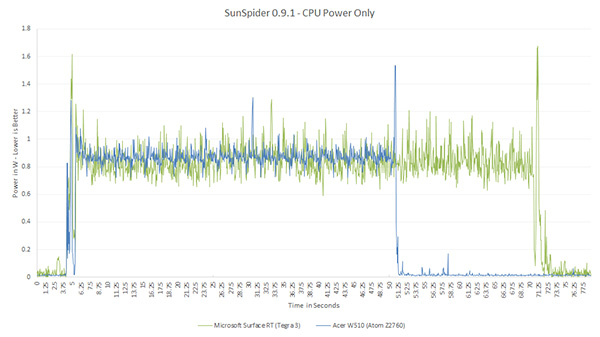

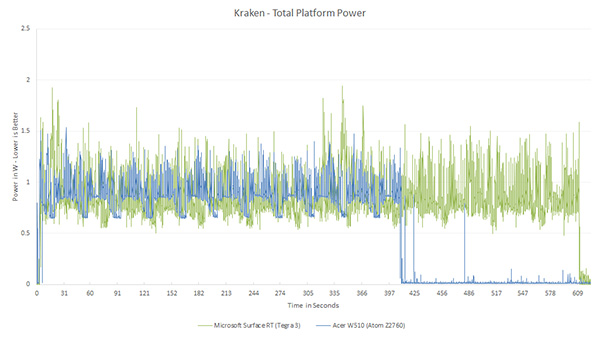
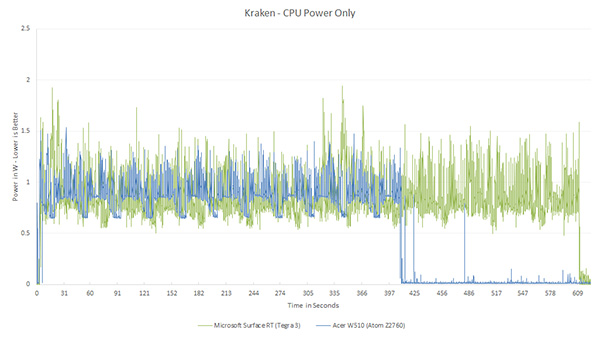

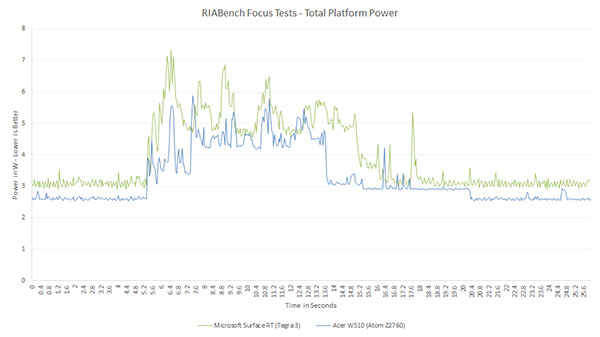
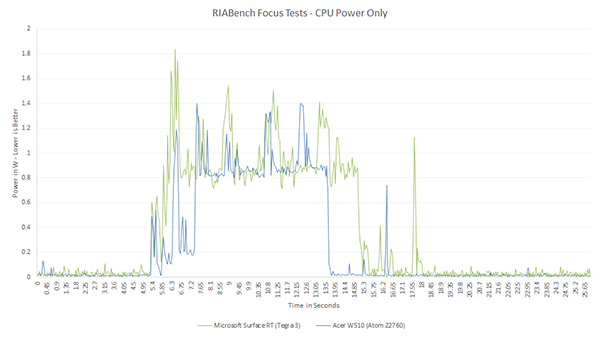
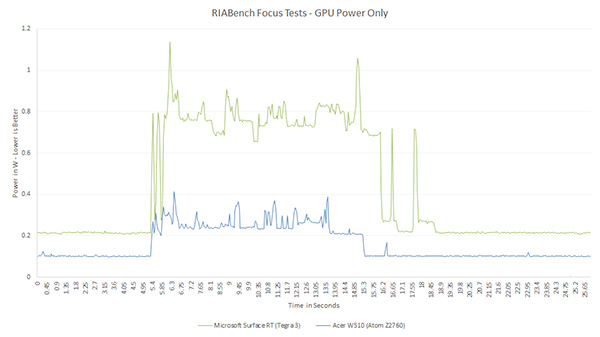








163 Comments
View All Comments
dangerjaison - Tuesday, December 25, 2012 - link
The only reason why arm could make this progress is bcoz of android and ios. They are built mainly to run on arm architecture. There are lots of issues mainly hardware acceleration in intel's architecture coz the developers build their games n apps to perform well on arm. The recently launches Intel device with atom running android had good backup and performance but couldn't succeed bcoz of compatibility. Intel still can make a big comeback to take over arm in mobile market.SilentLennie - Tuesday, December 25, 2012 - link
Euh... actually, everyone knew the NVidia product sucked on the power efficiency front.There is still a lot of work to do for Intel.
Blaster1618 - Tuesday, December 25, 2012 - link
One would think that Nvidia would have spent a couple of dollars to to work on their GPU efficiency. lolULP Geforce at 520 MHz in (40 nm) process easily beat a Power VR SGX545 (65 nm).
Even when when Nvida moves to (28 nm) technology next year it will move form a pig to a Pig-lite.
Another thought it is so Microsoft to make an ARM specific OS that does not support the 5th core on the Tegra 3.
CeriseCogburn - Friday, January 25, 2013 - link
Tegra4 is looking mighty fine, so whatever.Tegra3 was great when it came to gaming - it kept making Apple's best look just equal.
Microsoft may actually be the bloated pig syndrome company. I find it likely that the LP 5th tegra core wasn't enough to keep the fat msft pig OS running.
Of course it could just be their anti-competitive practice in full swing.
GillyBillyDilly - Tuesday, December 25, 2012 - link
but when I watch the power eaters on a Nexus 7, up to 90 percent is used up by display alone, which makes the cpu power efficiency somewhat seem irrelevant. Isn't it time to talk about display efficiency?CeriseCogburn - Friday, January 25, 2013 - link
Yep. Good point. No, great point, although it looks to be more like 40% for display power use on the new large screen mobile phones and phablets.shadi_h - Tuesday, December 25, 2012 - link
I really believe Microsoft missed a great opportunity to go forward with an Intel only CPU strategy (they already have the best development kits for x86). An Intel powered cellphone is what I really want! Maybe the RT version should have been Clover Trail w/ 32-bit and Pro w/ 64-bit. Their decision makes me believe they put too much emphasis getting easy app conversions from the iOS/Android communities and not creating the best hardware.jeffkibuule - Tuesday, December 25, 2012 - link
It's not such a great idea to hitch all of your hopes on Intel, they seem to only do their best work when they have a strong competitor.shadi_h - Tuesday, December 25, 2012 - link
True but that's not anyone's fault but AMD. it seems they have no clue how to even enter this space. That's puzzling since it can be argued they potentially could have the best overall SoC tech (thought that was the whole reason they bought ATI in the first place).Powerlurker - Wednesday, January 2, 2013 - link
AMD dumped their mobile lineup in 2008 and sold it to Qualcomm (now known as Adreno) and sold their STB lineup (Xilleon) to Broadcom. Anything they could have used is gone at this point.